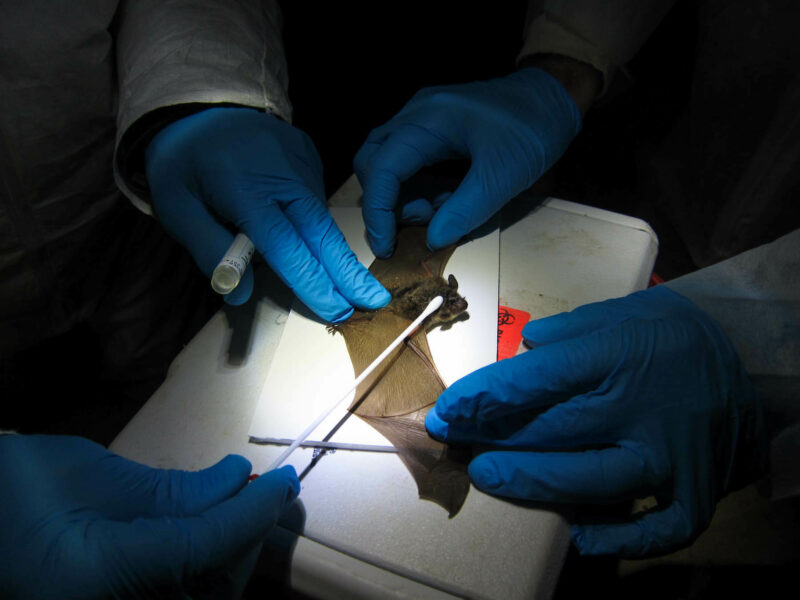Hunting an insidious disease that preys on bats

It’s the stuff of nightmares: during the winter hibernation of northern long-eared bats, a chalky-white fungus that’s attracted to cold, humid spaces grows over the mammal’s face, ultimately leading to weeks of erratic behavior that proves fatal for the creature.
The name of the disease is white-nose syndrome (WNS), and it has single-handedly decimated the population of various bat species in North America. You can think of WNS as a frightening form of sleep deprivation: the disease pathogen spreads between hibernating bats and causes them to wake up to warm temperatures more frequently, and often leave the cave or mine during daylight, potentially triggered by an immune response. This behavior burns off vital fat, which, when combined with the skin lesions left by the disease and disruptions to their metabolism, deeply impairs the bat’s ability to survive in the wild.
Northern long-eared bats, which are officially considered “threatened” due to WNS, are especially difficult to protect because they hibernate in areas where the pathogen likes to spread but in small colonies that are hard for park and forest managers to find. As with any good horror film, the northern long-eared is stuck out in an isolated location with a small group of friends. There is nowhere to run. Nowhere to hide.
Putting out the bat signal
Fortunately, a cross-continental group of biologists, researchers, land managers and bat lovers known as the White Nose Syndrome Response Team is on the case. Led by the U.S. Fish and Wildlife Service, the group has significantly accelerated what we know about WNS and how to keep it from spreading through bat colonies. Most recently, the team created best management practices that forest and park rangers can use to protect and cure infected bats, as well as decontamination practices to follow so that they don’t inadvertently spread the disease. A cutting-edge genetic test was also produced by the response team and is now used across the country.
“We can detect a pathogen on the bat before there’s even a sign of disease,” said Jonathan Reichard, Ph.D., national assistant coordinator for the response team. According to Reichard, only a single, microscopic-sized spore of the fungus is needed for the test to conclude that the bat has been infected.
Investigation from the response team shows that the disease, which was first cited in caves near Albany, New York in 2007, has now spread as far as Texas and across the Chesapeake Bay watershed. How the disease first entered bat communities or where it’s from is not known exactly; the fungal spores can last on surfaces such as clothes, shoes and outdoor gear for a long time, allowing it to spread easily.
Compared to other regions, cases of WSN are lower in the Chesapeake, but there have been massive outbreaks in the area in previous years and the disease continues to threaten remaining populations.
“Although these areas have already been through the drastic impacts of the disease, these diminished populations are still exposed to the fungus each winter and still get sick from it.” said Reichard. “The impacts of the disease on these populations now are less striking, but possibly even more important to their long-term health than the initial crashes.”
Why bats matter
Like many bats, the Northern long-eared plays an important role in the ecosystem, eating a wide variety of forest and crop pests that farmers would otherwise have to fend off with pesticides. Relying on bats to manage insect populations is a much greener and more effective way of limiting the negative effects that they have on human life and productivity.
The northern long-eared bat isn’t the cutest critter in the Chesapeake watershed, but in this monster-movie, it’s the victim, not the villain. If you’d like to learn more about a variety of bats native to the watershed, take a look at our Field Guide.

Comments
There are no comments.
Thank you!
Your comment has been received. Before it can be published, the comment will be reviewed by our team to ensure it adheres with our rules of engagement.
Back to recent stories